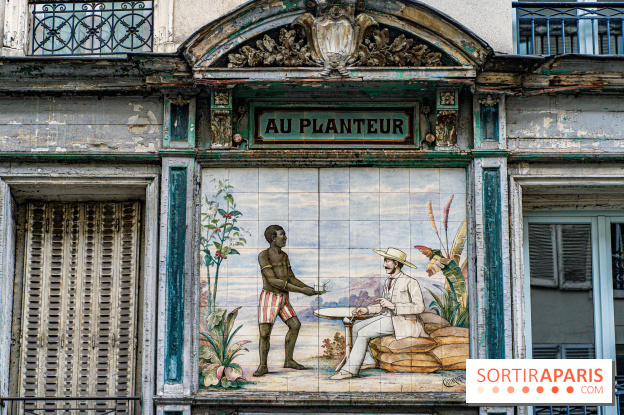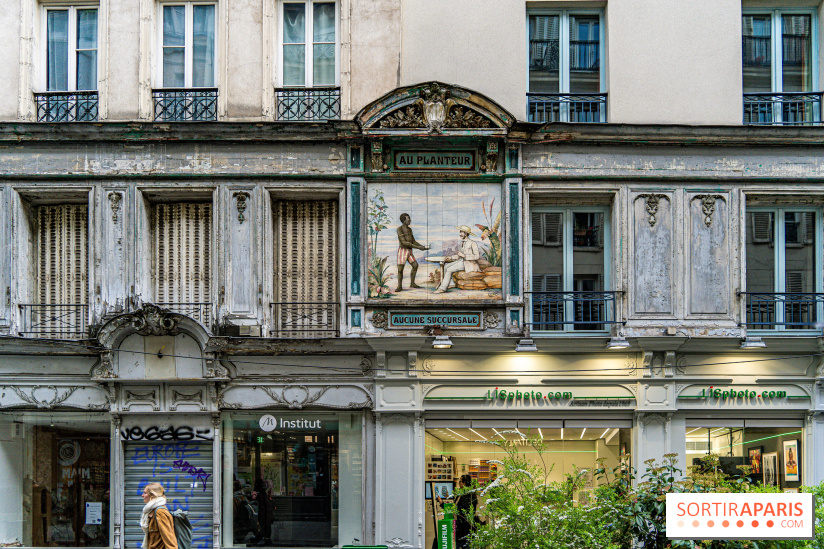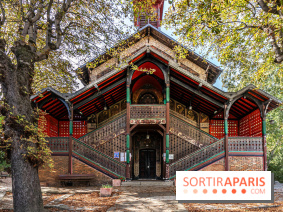On the streets of Paris, the Au Planteur facade at 10 rue des Petits-Carreaux remains a controversial subject. Listed as a historic monument since May 23, 1984, this ceramic painting dates from 1890 and depicts a black man in the service of a colonialist white man. It is one of the few testimonies of the French colonial era in the capital.
The illustration, entitled"Au Planteur", was installed on the facade of a 19th-century building to promote a store selling "exotic products", of which coffee was the main commodity on offer. At the time, the term "planteur" referred to a colonist who owned or operated a plantation. Today, this painting has provoked debate and shocked some passers-by, raising the question of its relevance in the Parisian public space.
Strolling between rue Montorgueil and rue des Petits-Carreaux, our attention is drawn to this strange illustration. As we look up at these charming old buildings, we catch a glimpse of this colonial scene from another era.
As a fervent defender of heritage, it is essential to preserve this fresco, but also to add an educational value to place the work in its historical context. The " Au planteur " sign bears witness to an imperialist and colonial past, a history that cannot be changed, but which must be remembered.
It's important not to forget this dark period in our history. As Jean-Claude Barreau and Guillaume Bigot put it in "Toute l'histoire du monde de la préhistoire à nos jours": "The French, and indeed all Westerners, have become, for the most part, men without a past, 'immémorants'". The presence of this fresco in the public space requires an explanation to give meaning to the images and question our history.
The "Au Planteur" sign is one of only two colonial-era signs still in Paris, the other being "Au Nègre Joyeux", deposited in 2018 and joining the collections of the Musée Carnavalet. The question of preserving or removing these signs is a delicate one, and has given rise to lively debate.
The Au Planteur facade in Paris raises ethical questions and invites reflection on our colonial past and whether or not it should be preserved. Preserving this fresco and adding a pedagogical value would allow us to preserve this historical testimony while engaging a reflection on memories and representations of the colonial era.
The preservation of these historical testimonies is crucial to ensure that our history is not obscured and that our past is understood. However, it would be interesting, indeed essential, to accompany these relics with educational and explanatory elements, so as not to trivialize the suffering and injustices experienced by the colonized populations.
The Au Planteur façade in Paris represents a unique opportunity for visitors to come face-to-face with a piece of French history, and to question the memorial and ethical issues it raises. The preservation of this fresco can thus contribute to a better understanding of our colonial past, while encouraging a constructive and enlightened dialogue on cultural and historical representations.
In the interests of respect and awareness, the preservation of the Au Planteur façade should be accompanied by an educational and explanatory approach. This would help contextualize the work, enrich our heritage and encourage an informed exchange on colonial memories and the ethical issues they raise.
Location
To the Planter
10 Rue des Petits Carreaux
75002 Paris 2
Prices
Free
Recommended age
For all























